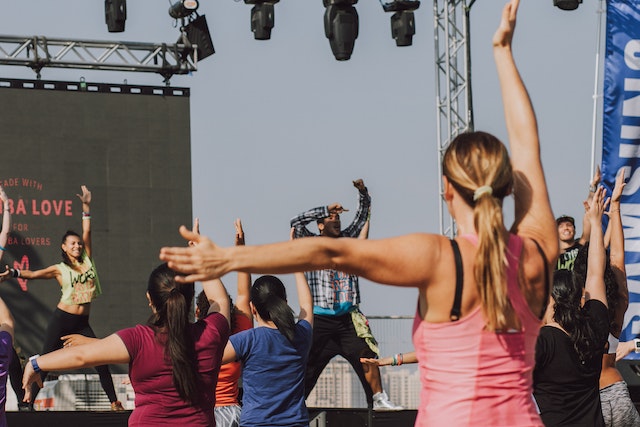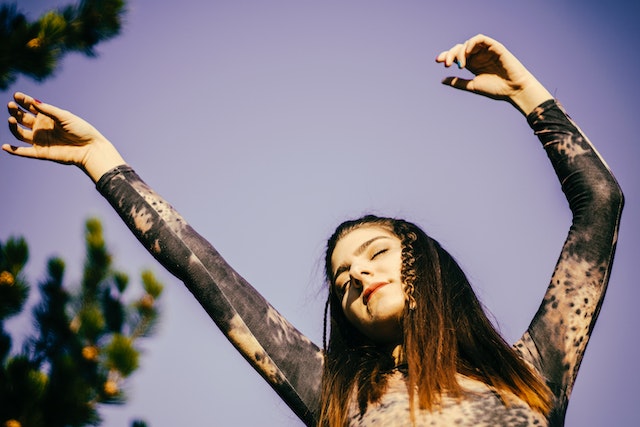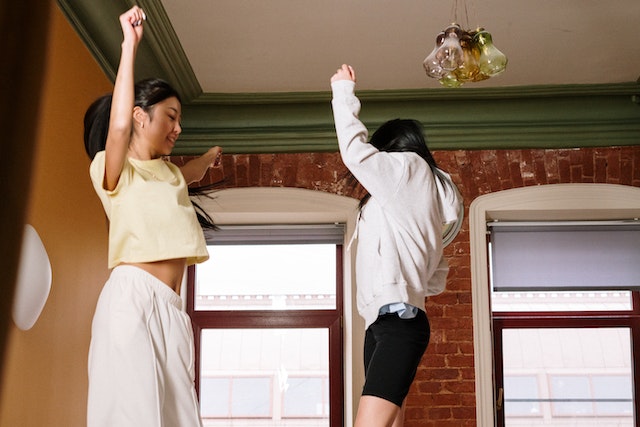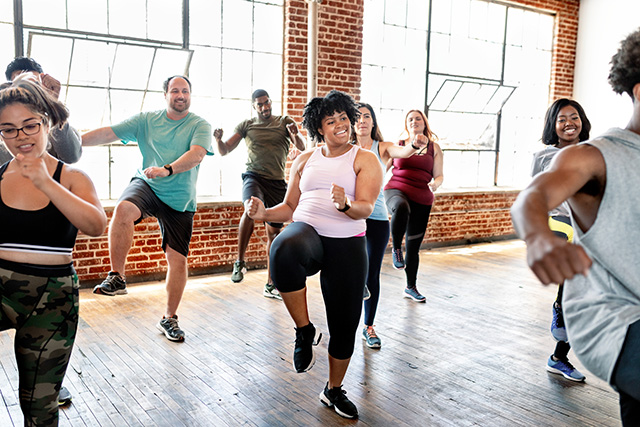Joining the Zumba Fun
Big Hair, Scrunchies, and Leggings
At first, I didn’t know much about Zumba, but immediately an image of big hair, scrunchies, and neon-colored leggings popped into my head. Those were the early days of Zumba! Luckily, I had the chance to speak to Larissa Demir (née Bala) on the podcast, who shared her love and passion for Zumba with me and what Zumba looks like today.
Zumba can certainly support your mental and physical health by reducing stress and elevating your mood. You can express yourself through movement in Zumba classes, and have a ton of fun by moving around and dancing. The body releases dopamine and other mood-elevating chemicals during exercise, which can even help reduce anxiety and depressive symptoms.
Larissa offers online Zumba classes for those who prefer to dance it out from home. Particularly those who find it difficult to leave the house or have other family or work commitments that prevent them from having the time to visit their local gym. Larissa shared that she used to be quite self-critical and lacked self-confidence.
Larissa fell in love with the energy and confidence Zumba gave her and began teaching to share her passion with her students.
“When you dance, you can enjoy the luxury of being you.”
- Paolo Coelho
For me, Zumba is an exciting option to try out because it has variations for low impact and persons with mobility challenges. It also offers the option of joining from home, which makes me a little less self-conscious about getting started. I would imagine most people experiencing mental distress or anxiety might feel the same way. Add in the fun music and Larissa’s infectious energy, and it’s sure to be an unforgettable session.
History of Zumba
Zumba has actually been around for quite some time now. A fitness instructor and choreographer called Alberto "Beto" Perez created Zumba in the mid-1990s. Zumba's official website states that it was born as a result of Beto forgetting his music while en route to teach an aerobics class. Since he was unable to return and get the tapes in time, he used the salsa and merengue tapes he had with him. In his session, he combined dance and aerobics to keep students moving and entertained.
He started teaching his unique blend of dance and aerobics in Miami in 2001 when he was also "lucky" to meet two more Albertos, Alberto Perlman and Alberto Aghion. Together, they came up with the word "Zumba," which stands for this fantastic blend of exercise and enjoyment despite having no precise definition. They later made it available at fitness centers all over the world.

Zumba was developed to be a low-impact, calorie-burning exercise that is extremely effective, and adaptable for people of different ages, body types, and fitness levels. Different types of Zumba have been developed to bring more inclusivity and now you can find Zumba for kids, for seniors, Zumba in the water, low-impact Zumba and much more.
Of course with the health pandemic, Zumba faced the same issues as physical gyms and many Zumba classes moved online. Although it took some getting used to, many people actually prefer online classes because it involves no commute and still gives the sense of a community. The social aspect is a big draw for participants and online communities are popping up for that purpose.
How Can You Do Zumba?
As Larissa explained, Zumba is a Latin-rhythm-based dance exercise class. Numerous Latin rhythms are mixed in, including merengue, cumbia, reggaeton, salsa, and reggae. But it also draws inspiration from various international rhythms. As a result, you can listen to music for soccer, belly dancing, and Bhangra all in one session, depending on your instructor.
It’s the exciting music and the feeling of belonging to a close-knit, fun group that is a huge positive benefit of Zumba. Classes don't require any special dance abilities, but individuals with a natural sense of rhythm might pick up the moves more quickly. Nevertheless, nobody is keeping score, so you can just dance, relax, and enjoy yourself.

I had also asked Larissa if Zumba is adapted to people with mobility issues and she let me know that modifications are always possible. So, if you are feeling that movement might be good for you, but you have some mobility challenges or don’t know where to start, speak with a Zumba instructor to find the best way for your unique situation.
Now that physical classes are coming back, you can check for a class close to where you live or meet up with Larissa online. Different instructors are putting on a variety of classes and you might find something you really enjoy. You can join virtual classes live, which could be great if you love the social aspect. And you can also take on-demand classes, if you prefer to just get into the rhythm and enjoy the workout.
Benefits of Zumba
Zumba can actually help with different aspects of mental health. When you exercise and dance, the brain releases hormones like serotonin, which improve your mood. In general, exercise can help you let out any pent-up stress or worry. And it can also help lower the level of stress hormones in your body. We love doing things we enjoy, and Zumba is just one of those fun things.
If you are taking virtual classes, you may be more relaxed because you are tuning in from the comfort of your own home. Sometimes, the stares at the gym kept me from even wanting to go in there. So, virtual exercise groups are something I have found encouraging, supporting, and safe. With Zumba, you are simply keeping up with the music and getting swept up in the beat. Especially if you are dealing with any social anxiety, this could be a great solution.

There are a few other benefits that can indirectly affect your mental health as well. Zumba is obviously a workout and you will find that it works and tones your muscles. This could have a positive impact on your weight and also on your overall well being and coordination. You may also become more mobile and flexible, which could help with those little aches and pains you may be experiencing.
And Zumba can also affect confidence. Whether you feel better because you have more energy, or you feel more in shape because you are exercising, increased self-confidence can have a positive impact on your mental health. And the nice thing is that you can even start Zumba with your camera off, until you feel comfortable joining the class with live video. There is no pressure and you can simply move along at your own pace and comfort.
The Takeaway
One of Zumba's most notable advantages is that it is a fantastic stress reliever. You are burning inches, getting toned, sweating, and working on that wonderful glow. It enhances cardiovascular fitness, can lower blood pressure, and improve overall quality of life.
By the end of a Zumba session, you may actually feel like a changed person. There are more benefits to Zumba as well. It can help get you energized, enhance your cognitive abilities, reduce stress, and add some joy or passion to the daily grind. And anyone can start, as there are no special requirements.

Another wonderful addition to your mental health journey could be virtual Zumba classes.
Larissa offers many online classes, to make your day or evening more enjoyable. Even though you are participating in a virtual workout, the experience can be very much like any other Zumba social workout. Many participants start to get to know each other and even connect online outside of classes.
Just be sure that you listen to your body and work within what is comfortable for you. One of the reasons people quit exercise is because they initially push themselves too hard and then burn out or injure themselves. Zumba can certainly challenge you and it will be lots of fun. For starters, give yourself time to rest after a session and do only as much as you enjoy. Pushing yourself past your comfort zone might lead to unintended injuries and muscle discomfort. You want to be sure you’ll enjoy it for a long time to come.
So, take a look online and find a Zumba class you will enjoy! That’s what it is really all about.
Sources
Barene, S., & Krustrup, P. (2022, February 1). Football and Zumba Training in Female Hospital Staff: Effects after 12 and 40 Weeks on Self-Reported Health Status, Emotional Wellbeing, General Self-Efficacy and Sleep Problems. International Journal of Environmental Research and Public Health, 19(3), 1685. https://doi.org/10.3390/ijerph19031685
Kallivayalil J., Priya J., Devi G., Arivarasu, L. (2021). Influence of Yoga and Zumba on Memory among South Indian Populations - A Survey. Annals of the Romanian Society for Cell Biology, 25(2), 2640–2647.
Suri, M., Sharma, R., Saini, N. (2017). Physiological responses of Zumba: An overview understanding the popular fitness trend. Indian Journal of Physical Education, Sports and Applied Science, 7(4).
Zarańska, B. (2022). Zumba Training and Stress and Coping Strategies used by Women. International Journal of Latest Research in Humanities and Social Science, 5(4). http://www.ijlrhss.com/paper/volume-5-issue-4/9-HSS-1326.pdf
https://thejornipodcast.com/episode-18-zumba-with-larissa-bala
